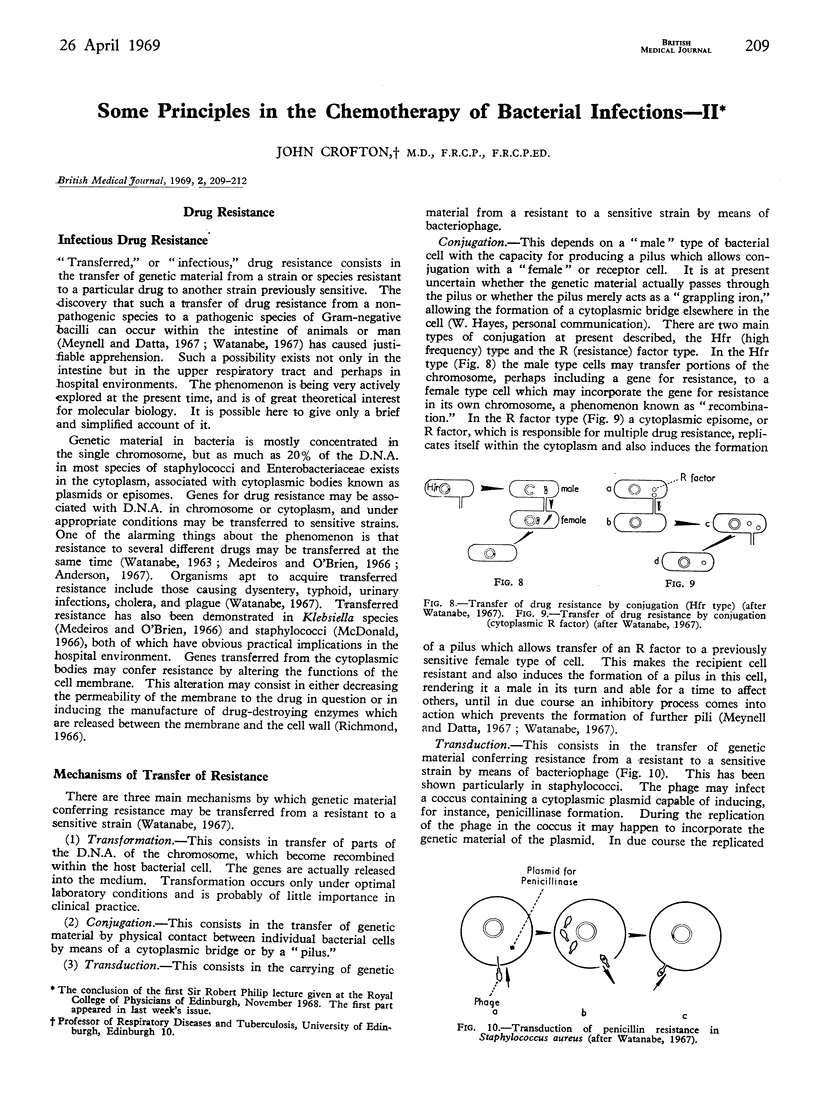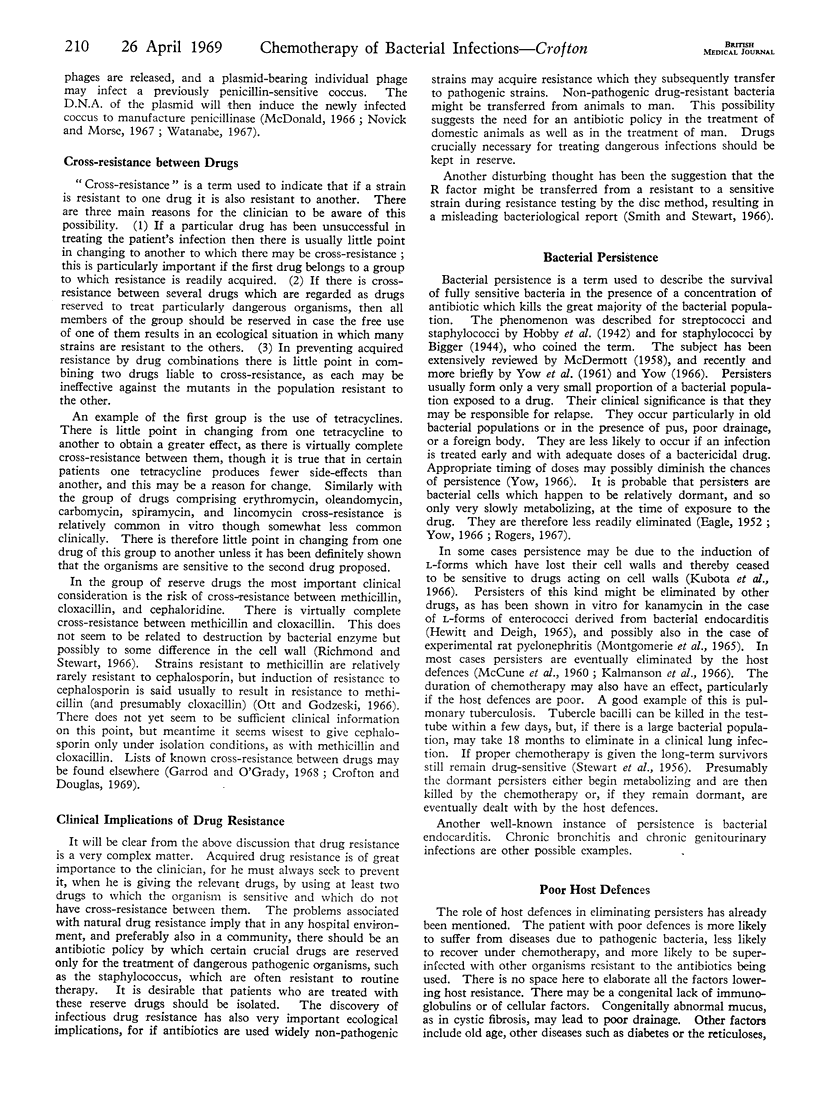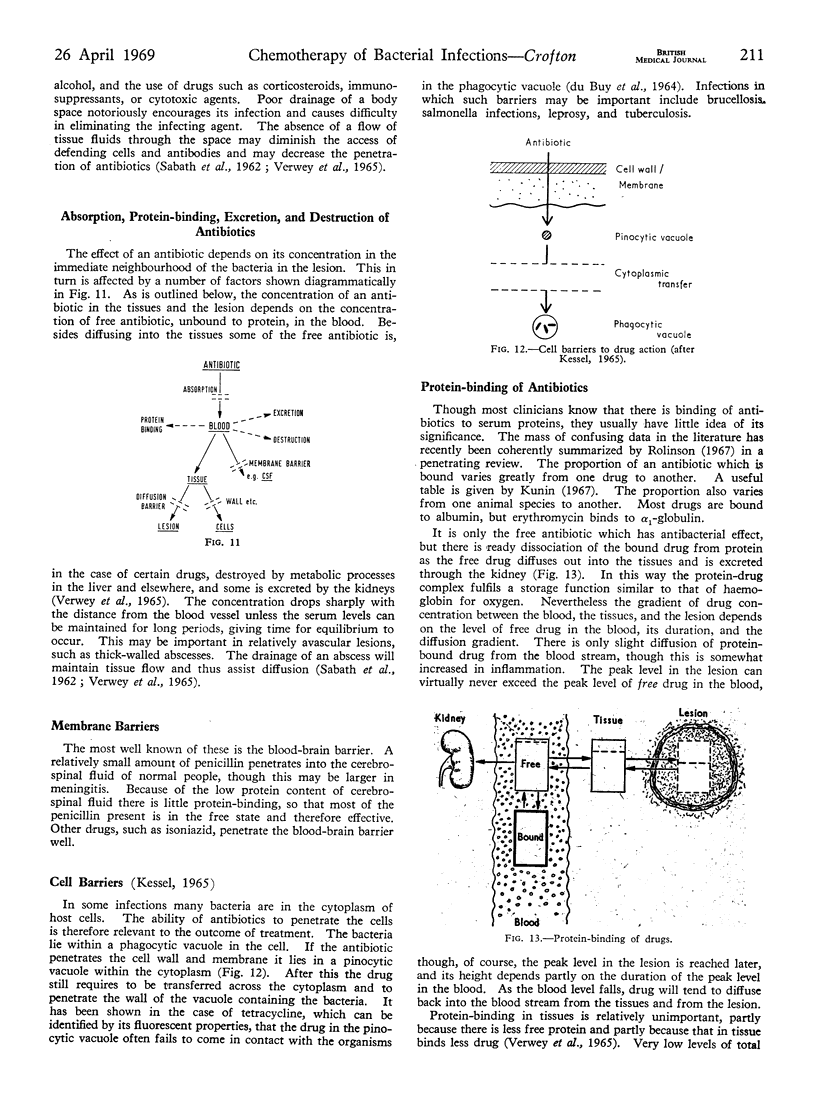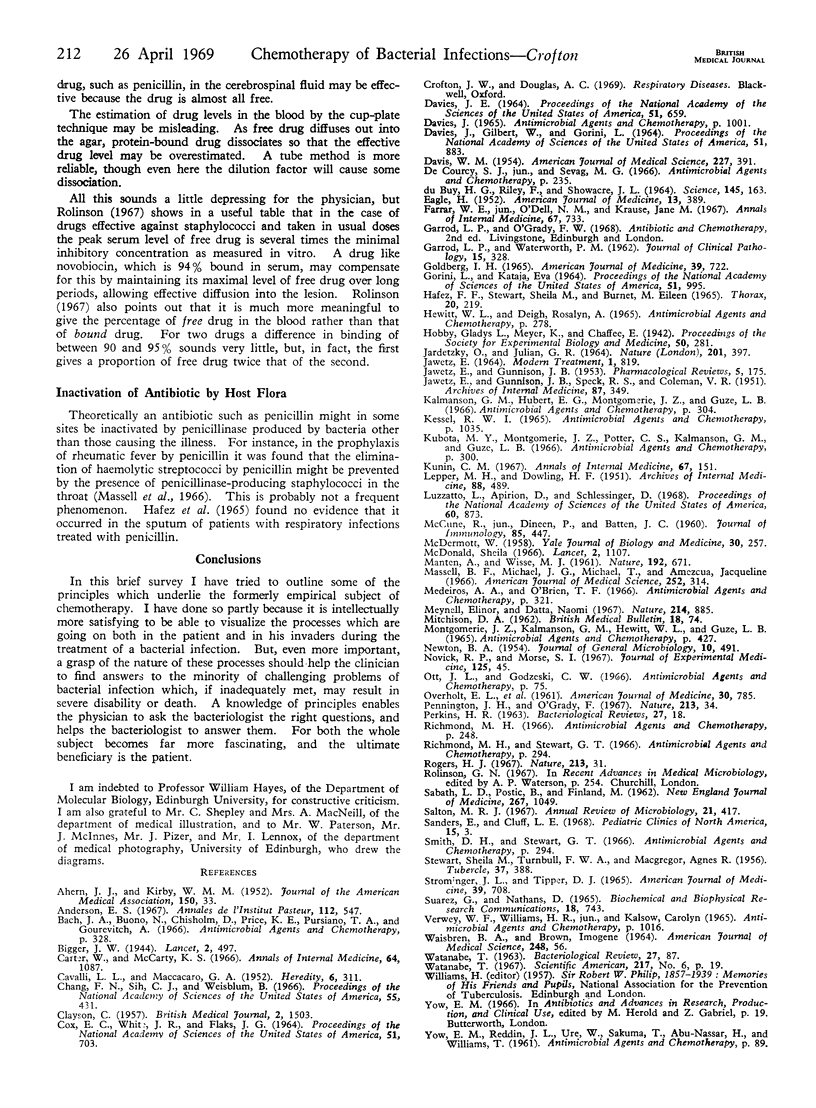Full text
PDF



Selected References
These references are in PubMed. This may not be the complete list of references from this article.
- Anderson E. S. Facteurs de transfert et résistance aux antibiotiques chez les entérobactéries. Ann Inst Pasteur (Paris) 1967 May;112(5):547–563. [PubMed] [Google Scholar]
- Bach J. A., Buono N., Chisholm D., Price K. E., Pursiano T. A., Gourevitch A. In vitro and in vivo synergism of mixtures of penicillins. Antimicrob Agents Chemother (Bethesda) 1966;6:328–336. [PubMed] [Google Scholar]
- CLAYSON C. Sir Robert Philip and the conquest of tuberculosis. Br Med J. 1957 Dec 28;2(5060):1503–1508. doi: 10.1136/bmj.2.5060.1503. [DOI] [PMC free article] [PubMed] [Google Scholar]
- Carter W., McCarty K. S. Molecular mechanisms of antibiotic action. Ann Intern Med. 1966 May;64(5):1087–1113. doi: 10.7326/0003-4819-64-5-1087. [DOI] [PubMed] [Google Scholar]
- DAVIES J., GILBERT W., GORINI L. STREPTOMYCIN, SUPPRESSION, AND THE CODE. Proc Natl Acad Sci U S A. 1964 May;51:883–890. doi: 10.1073/pnas.51.5.883. [DOI] [PMC free article] [PubMed] [Google Scholar]
- DAVIS W. M. Successful treatment of pneumococcal pneumonia with combination of chloramphenicol and penicillin. Am J Med Sci. 1954 Apr;227(4):391–397. doi: 10.1097/00000441-195404000-00004. [DOI] [PubMed] [Google Scholar]
- DUBUY H. G., DUBUY H. G., RILEY F., SHOWACRE J. L. TETRACYCLINE FLUORESCENCE IN PERMEABILITY STUDIES OF MEMBRANES AROUND INTRACELLULAR PARASITES. Science. 1964 Jul 10;145(3628):163–165. doi: 10.1126/science.145.3628.163. [DOI] [PubMed] [Google Scholar]
- Davies J. Effects of streptomycin and related antibiotics on protein synthesis. Antimicrob Agents Chemother (Bethesda) 1965;5:1001–1005. [PubMed] [Google Scholar]
- EAGLE H. Experimental approach to the problem of treatment failure with penicillin. I. Group A streptococcal infection in mice. Am J Med. 1952 Oct;13(4):389–399. doi: 10.1016/0002-9343(52)90293-3. [DOI] [PubMed] [Google Scholar]
- Farrar W. E., Jr, O'Dell N. M., Krause J. M. Use of penicillinase-resistant penicillins to increase the susceptibility of gram-negative bacteria to antibiotics. Ann Intern Med. 1967 Oct;67(4):733–743. doi: 10.7326/0003-4819-67-4-733. [DOI] [PubMed] [Google Scholar]
- GARROD L. P., WATERWORTH P. M. Methods of testing combined antibiotic bactericidal action and the significance of the results. J Clin Pathol. 1962 Jul;15:328–338. doi: 10.1136/jcp.15.4.328. [DOI] [PMC free article] [PubMed] [Google Scholar]
- GORINI L., KATAJA E. STREPTOMYCIN-INDUCED OVERSUPPRESSION IN E. COLI. Proc Natl Acad Sci U S A. 1964 Jun;51:995–1001. doi: 10.1073/pnas.51.6.995. [DOI] [PMC free article] [PubMed] [Google Scholar]
- Goldberg I. H. Mode of action of antibiotics. II. Drugs affecting nucleic acid and protein synthesis. Am J Med. 1965 Nov;39(5):722–752. doi: 10.1016/0002-9343(65)90094-x. [DOI] [PubMed] [Google Scholar]
- HAFEZ F. F., STEWART S. M., BURNET M. E. PENICILLIN LEVELS IN SPUTUM. Thorax. 1965 May;20:219–225. doi: 10.1136/thx.20.3.219. [DOI] [PMC free article] [PubMed] [Google Scholar]
- JARDETZKY O., JULIAN G. R. CHLORAMPHENICOL INHIBITION OF POLYURIDYLIC ACID BINDING TO E. COLI RIBOSOMES. Nature. 1964 Jan 25;201:397–398. doi: 10.1038/201397a0. [DOI] [PubMed] [Google Scholar]
- JAWETZ E., GUNNISON J. B. Antibiotic synergism and antagonism; an assessment of the problem. Pharmacol Rev. 1953 Jun;5(2):175–192. [PubMed] [Google Scholar]
- JAWETZ E., GUNNISON J. B., SPECK R. S., COLEMAN V. R. Studies on antibiotic synergism and antagonism; the interference of chloramphenicol with the action of penicillin. AMA Arch Intern Med. 1951 Mar;87(3):349–359. doi: 10.1001/archinte.1951.03810030022002. [DOI] [PubMed] [Google Scholar]
- Kalmanson G. M., Hubert E. G., Montgomerie J. Z., Guze L. B. Killing of microbial protoplasts by serum. Antimicrob Agents Chemother (Bethesda) 1966;6:304–307. doi: 10.1128/AAC.6.3.304. [DOI] [PubMed] [Google Scholar]
- Kubota M. Y., Montgomerie J. Z., Potter C. S., Kalmanson G. M., Guze L. B. Effect of penicillin concentration on "protoplast" production of Streptococcus faecalis. Antimicrob Agents Chemother (Bethesda) 1966;6:300–303. doi: 10.1128/AAC.6.3.300. [DOI] [PubMed] [Google Scholar]
- Kunin C. M. A guide to use of antibiotics in patients with renal disease. A table of recommended doses and factors governing serum levels. Ann Intern Med. 1967 Jul;67(1):151–158. doi: 10.7326/0003-4819-67-1-151. [DOI] [PubMed] [Google Scholar]
- LEPPER M. H., DOWLING H. F. Treatment of pneumococcic meningitis with penicillin compared with penicillin plus aureomycin; studies including observations on an apparent antagonism between penicillin and aureomycin. AMA Arch Intern Med. 1951 Oct;88(4):489–494. doi: 10.1001/archinte.1951.03810100073006. [DOI] [PubMed] [Google Scholar]
- Luzzatto L., Apirion D., Schlessinger D. Mechanism of action of streptomycin in E. coli: interruption of the ribosome cycle at the initiation of protein synthesis. Proc Natl Acad Sci U S A. 1968 Jul;60(3):873–880. doi: 10.1073/pnas.60.3.873. [DOI] [PMC free article] [PubMed] [Google Scholar]
- MACGREGOR A. R., STEWART S. M., TURNBULL F. W. The influence of chemotherapy on the bacterial content of tuberculous pulmonary lesions. Tubercle. 1956 Dec;37(6):388–403. doi: 10.1016/s0041-3879(56)80183-9. [DOI] [PubMed] [Google Scholar]
- MANTEN A., WISSE M. J. Antagonism between antibacterial drugs. Nature. 1961 Nov 18;192:671–672. doi: 10.1038/192671a0. [DOI] [PubMed] [Google Scholar]
- MCCUNE R., DINEEN P., BATTEN J. C. The influence of antimicrobial agents on total populations of Staphylococci in animal tissues. J Immunol. 1960 Nov;85:447–464. [PubMed] [Google Scholar]
- MITCHISON D. A. Microbial genetics and chemotherapy. Br Med Bull. 1962 Jan;18:74–80. doi: 10.1093/oxfordjournals.bmb.a069939. [DOI] [PubMed] [Google Scholar]
- Massell B. F., Michael J. G., Michael T., Amezcua J. Temporary suppression of penicillinase-producing staphylococci in the throat flora by oxytetracycline. Am J Med Sci. 1966 Sep;252(3):314–322. doi: 10.1097/00000441-196609000-00011. [DOI] [PubMed] [Google Scholar]
- McDERMOTT W. Microbial persistence. Yale J Biol Med. 1958 Feb;30(4):257–291. [PMC free article] [PubMed] [Google Scholar]
- McDonald S. Transduction of antibiotic resistance in Staphylococcus aureus. Lancet. 1966 Nov 19;2(7473):1107–1110. doi: 10.1016/s0140-6736(66)92196-9. [DOI] [PubMed] [Google Scholar]
- Meynell E., Datta N. Mutant drug resistant factors of high transmissibility. Nature. 1967 May 27;214(5091):885–887. doi: 10.1038/214885a0. [DOI] [PubMed] [Google Scholar]
- Montgomerie J. Z., Kalmanson G. M., Hewitt W. L., Guze L. B. Effectiveness of antibiotics against the bacterial and "protoplast" phases of pyelonephritis. Antimicrob Agents Chemother (Bethesda) 1965;5:427–430. [PubMed] [Google Scholar]
- NEWTON B. A. Site of action of polymyxin on Pseudomonas aeruginosa: antagonism by cations. J Gen Microbiol. 1954 Jun;10(3):491–499. doi: 10.1099/00221287-10-3-491. [DOI] [PubMed] [Google Scholar]
- Novick R. P., Morse S. I. In vivo transmission of drug resistance factors between strains of Staphylococcus aureus. J Exp Med. 1967 Jan 1;125(1):45–59. doi: 10.1084/jem.125.1.45. [DOI] [PMC free article] [PubMed] [Google Scholar]
- OVERHOLT E. L., TIGERTT W. D., KADULL P. J., WARD M. K., CHARKES N. D., RENE R. M., SALZMAN T. E., STEPHENS M. An analysis of forty-two cases of laboratory-acquired tularemia. Treatment with broad spectrum antibiotics. Am J Med. 1961 May;30:785–806. doi: 10.1016/0002-9343(61)90214-5. [DOI] [PubMed] [Google Scholar]
- PERKINS H. R. Chemical structure and biosynthesis of bacterial cell walls. Bacteriol Rev. 1963 Mar;27:18–55. doi: 10.1128/br.27.1.18-55.1963. [DOI] [PMC free article] [PubMed] [Google Scholar]
- SABATH L. D., POSTIC B., FINLAND M. Methicillin treatment of severe staphylococcal disease. Observations in 146 cases. N Engl J Med. 1962 Nov 22;267:1049–1057. doi: 10.1056/NEJM196211222672101. [DOI] [PubMed] [Google Scholar]
- Salton M. R. Structure and function of bacterial cell membranes. Annu Rev Microbiol. 1967;21:417–442. doi: 10.1146/annurev.mi.21.100167.002221. [DOI] [PubMed] [Google Scholar]
- Sanders E., Cluff L. E. Mechanisms of action of antimicrobial agents. Pediatr Clin North Am. 1968 Feb;15(1):3–11. doi: 10.1016/s0031-3955(16)32084-3. [DOI] [PubMed] [Google Scholar]
- Strominger J. L., Tipper D. J. Bacterial cell wall synthesis and structure in relation to the mechanism of action of penicillins and other antibacterial agents. Am J Med. 1965 Nov;39(5):708–721. doi: 10.1016/0002-9343(65)90093-8. [DOI] [PubMed] [Google Scholar]
- Verwey W. F., Williams H. R., Jr, Kalsow C. Penetration of chemotherapeutic agents into tissues. Antimicrob Agents Chemother (Bethesda) 1965;5:1016–1024. [PubMed] [Google Scholar]


